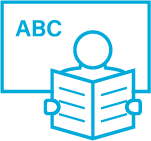How Children Read Words

Reading phonologically means that children read words by converting letters into sounds. They could use grapheme–phoneme relations or intra-syllabic units, onset, and rime. There is little direct evidence that children who are learning to read rely on letter-sound relationships to help them read words. There is a great deal of evidence that they adopt a global strategy.
Authors: Usha Goswami & Peter Bryant
Source: Goswami, U. & Bryant, P. (2016). How children read words. Chapter 2 in a book Phonological Skills and Learning to Read. ISBN: 978-1-315-69506-8 (ebk).
This book chapter considers how children read words. Do they read words phonological or in some other way? Reading phonologically means that children read words by converting letters into sounds. They could use grapheme–phoneme relations or intra-syllabic units, onset, and rime. There is very little direct evidence that children who are learning to read do rely on letter-sound relationships to help them read words. There is a great deal of evidence that they adopt a global strategy.
Different ways to read words
- Children may read words phonologically or in some other way.
- Reading phonologically means that children read words by converting letters into sounds: using grapheme–phoneme relations or intra-syllabic units, or onset and rime.
- Although many English words could be read with the help of letter-sound relationships, not all can be read this way, because the English script is too unpredictable.
- Thus, there needs to be another way of reading.
- One approach is often called the visual (or global) strategy.
- It is possible to recognise particular familiar words as visual patterns.
- To read words as wholes without paying attention to the individual letters is to read in the same way as the Japanese read kanji characters.
- Children might initially learn to read words based on letter-sound relationships, and then much later they might come to recognise them as familiar wholes.
- Research has shown that beginning readers can read words without the help of phonology.
- Thus, even beginning readers can read whole words without analysing the grapheme–phoneme relations in those words; rather, it is possible to take quite easily to reading words as logograms.
Comparison between reading strategies
- It seems that better readers use more the grapheme–phoneme relations but weaker readers have problems with reading based on letter-sound relationships.

Conclusions
- There is little direct evidence that children who are learning to read rely on letter-sound relationships to help them read words.
- There is a great deal of evidence that these young children take easily and naturally to reading words in other ways: they adopt a global strategy, which means that they either recognise the word as a pattern or remember it as a sequence of letters.
- However, children depend heavily on letter-sound relations when they write words.